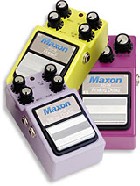
Japan’s Maxon company has made some of the most popular guitar effects pedals of all time. But because they carried a different brand, you might not equate the box with the name. Here’s a not-so-subtle hint: green boxes. Need another? The letters T and S.
Got it? Good, because the original-issue versions of those pedals have achieved grail-like status in the vintage instrument market, so it makes sense Maxon would offer them once again.
We recently played around with three more pedals from the company’s Nine Series reissues of those famous pedals, the FL-9 Flanger, CS-9 Pro Stereo Chorus, AD-9 Analog Delay (we tested the SD-9 Distortion, OD-9 Overdrive, and AF-9 Auto Filter in the November ’02 issue) using an Ibanez Artist guitar with Wolfetone Greywolf pickups and an all-tube Peavey Butcher head through a 2×12″ cabinet.
Since first reissuing the line, Maxon has improved it with upgraded circuitry (including a Signetics NE570 compander) and true-bypass switching courtesy of a 4PDT. Those improvements were immediately noticeable when we plugged in the AD-9 Analog Delay, which was ultra warm and exceptionally quiet (our signal almost seemed quieter with effect delay on!), and absolutely devoid of signal coloration. We dialed in a rockabilly slap-back echo and found it to be very vintage-like, with all the requisite warmth.
Dialing in more delay and slower repeats, and with a touch more distortion on the amp, we got that classic soughtafter “big-hall” rock sound of our youth.
We then cleaned it up again and sped up the delay, increased the repeats, and achieved what could be best described as “bathroom” sound. The repeats deteriorated like they should when we increased the rate and slowed the delay time. There’s nothing warmer than an analog circuit! After trying this unit, you will not want to go back to digital.
The FL-9 Flanger uses controls for speed, width, re-generation (controls the effects intensity) and a delay time. Again, the pedal’s sound was appreciably warm, transparent, and our signal was quieter with the pedal on. We experimented with the sample setting for classic flange and found it to be just that – classic!
Adjusting the delay time to various settings, we dialed in a host of flange tones. Slowing the speed to off and with the width turned down, re-generation turned up, and adjusting the delay time, the pedal produced a very strange tone, almost like playing inside a metal tank. We then recalled the standard flange setting, increased the amp’s distortion, and added the AD-9 Delay. Switching to the bridge pickup, we found a familiar Van Halen-like tone.
Finally, we plugged in the CS-9 Pro. This is, very simply, one of the warmest chorus pedals we’ve heard. Set to standard chorus effect, we experienced deep, lush chorus, with absolutely no harshness.
Maxon includes sample settings with each pedal, and we tried the CS-9 Pro’s setting number one. Turning up the amp’s gain, we got a huge, very fluid tone. Awesome! We then tweaked the controls to get a variety of tremolo effects. For kicks, we hooked it up in stereo, with the help of a Vox Berkely. Now that’s chorus. After trying the Deep Chorus setting, we almost had to be hosed down!
These three pedals certainly complement the Maxon Nine Series reputation for being outstanding, with all the warm characteristics you’d expect from true vintage effects… but without the noise. Each is built like a tank. And while this kind of quality and sound comes at a price, these are easily worth the extra few bucks.
Maxon AD-9, CS-9, and FL-9 effects pedals
Features Heavy-duty die-cast zinc chassis, true-bypass switching, LED power/battery indicator, AC/DC operation. AD-9: stereo outputs and controls for delay time, repeat, and delay level. CS-9: stereo outputs, controls for speed, width, delay time, and blend. FL-9: controls for speed, width, regeneration, delay time
Price $400 (AD-9), $299 (CS-9), $320 (FL-9).
Contact Godlyke Distribution, PO Box 3076, Clifton NJ 07012, phone (866) 246-3595, www.godlyke.com.
This article originally appeared in VG‘s Oct. ’04 issue. All copyrights are by the author and Vintage Guitar magazine. Unauthorized replication or use is strictly prohibited.


